
| Photos From Wyoming Tales and Trails This Page: Meeteetse continued, Blackfooted ferrets |
 |

| Photos From Wyoming Tales and Trails This Page: Meeteetse continued, Blackfooted ferrets |
 |
|
|
|
About This Site |
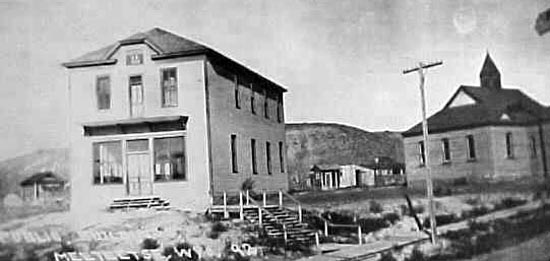 Masonic Hall, on left, and Meeteetse School, on right, approx. 1906 The first school in Meeteetse was established in in 1880 by Margaret Wilson. The school depicted was used as a meeting place for the Masonic, Woodsmen of the World and the Odd Fellows Lodges. The Masonic Hall was constructed in 1900 at a cost of $6,500. The lodge went dark in 1976 and merged with the Cody Masonic lodge. Ironically, Meeteetse's Signet Lodge was the older of the two and, in fact, had sponsored the formation of the lodge in Cody. The building was subsequently conveyed to the Meeteetse Museums.
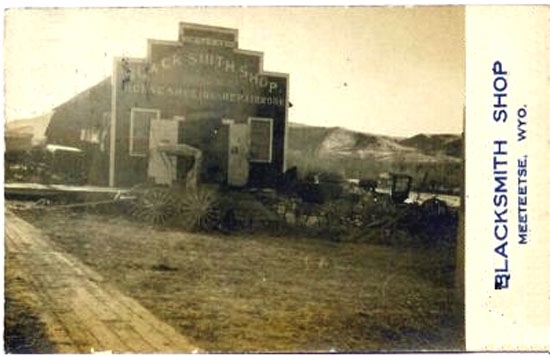 Meeteetse Blacksmith, 1906
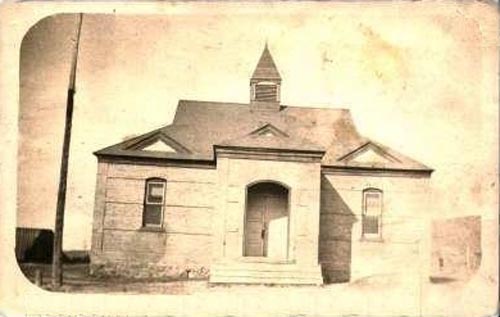 Meeteetse High School, 1911 In the early days there were no Catholic priests in the area. Commencing in 1906, a young German priest, the Rev. Nicholas J. Endres, was assigned to Cody. the Rev.Endres would ride circuit over a two week period, saying Mass on Sunday in Cody and Powell. He then proceeded on weekdays to the small towns in the Big Horn Basin working his way down to Thermopolis. He then returning by way of Meeteetse where he would conduct services in the home of Angus McDonald. Until automobiles came into general use, the priest would travel by stage. The roads were described as having dust a foot thick, resulting in the passengers lining up at the water trough to wash up when the stage stopped for a lunch break. Halfway between Cody and Meeteetse was the Midway Stage Station, a dugout in the side of a hill. The station, although it was crude, even had a public telephone. The stage line used spring wagons for coaches. The Reverend Endres in Extension Magazine, June, 1930, described his first trip into Meeteetse: Chief among the nightmares and disagreeable memories of the past is the famous horse-coach. Nothing was slower, nothing more uncomfortable, nothing more disagreeable than this old conveyance. The dust and heat in the summer, the bitter cold of winter nights, the poor meals served at the half-way station, and often the unwelcome company, all added their bit to the general discomfort. On my first trip to Meeteetse some men got on half drunk, and as I was unfamiliar with English, I was made acquainted with all the swear words of the language. 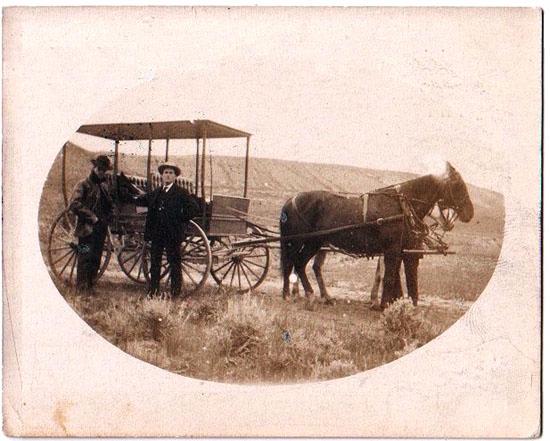 Spring wagon stage, Bighorn Basin, 1906.
"One young eastern fellow rode the stage from Cody to Meeteetse and when asked if he would ride it back replied it would be a whole lot more comfortable to walk back. Andy Wilson said he wouldn’t pay a dollar to ride from Meeteetse to Thermopolis, couldn’t earn a dollar easier than to just light out and walk it."
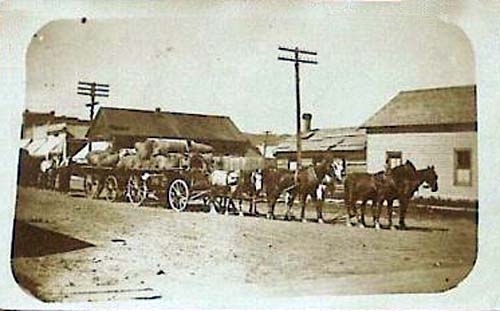 Freight Team, Meeteetse, approx. 1906
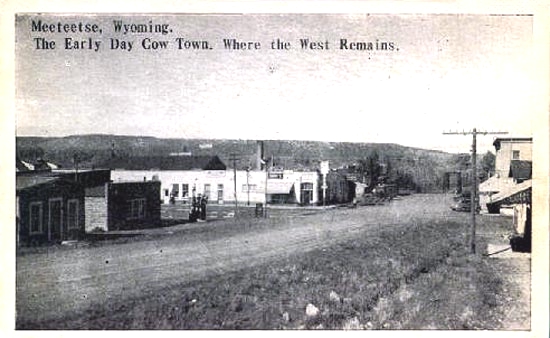 Meeteetse, approx. 1940 The two-story building on the right is the Meeteetse Mercantile. The Meeteetse Museum is now housed in the one-story white building in the center of the postcard. Meeteetse is also noted as being the location of the last colony of wild black-footed ferrets in the United States. In 1981, Shep, a dog belong to John and Lucille Hogg, presented his owners with a gift, a strange weasel-like dead animal. Mrs. Hogg showed it to a knowlegible wildlife official who recognized it as the "extinct" black-footed ferret. As a result two things happened: (a) a search was conducted for more ferrets, resulting in the discovery of the colony, and (b) the possiblity that the Hoggs would be charged with a violation of the Endangered Species Act for permitting Shep to "take" a listed species, notwithstanding that had Shep not "taken" the ferret, the colony would not have been discovered and the ferret would have remained extinct. Section 9 of the Endangered Species Act prohibits the "taking" of endangered wildlife. The term "take" is defined to include "harass, harm, pursue, hunt, shoot, wound, kill, trap, capture, or collect, or to attempt to engage in any such conduct." Taking includes "harming." "Harming" includes acts resulting in significant impact on essential behavior patterns including breeding, feeding or sheltering. It is a crime to knowlingly take an endangered species. The black-footed ferret has always rare. After it was discovered by John James Audubon, another sighting did not occur for 25 years. This resulted in the accusation that Audubon faked the discovery of the animal. The animal is also susceptible to sylvatic plague spread by fleas and to canine distemper. The colony at Meeteetse was significantly reduced in numbers by these diseases. All remaining ferrets were captured and bred in capitivity for reintroduction to the wild. Next page: Meeteetse continued, Charles J. Belden. |